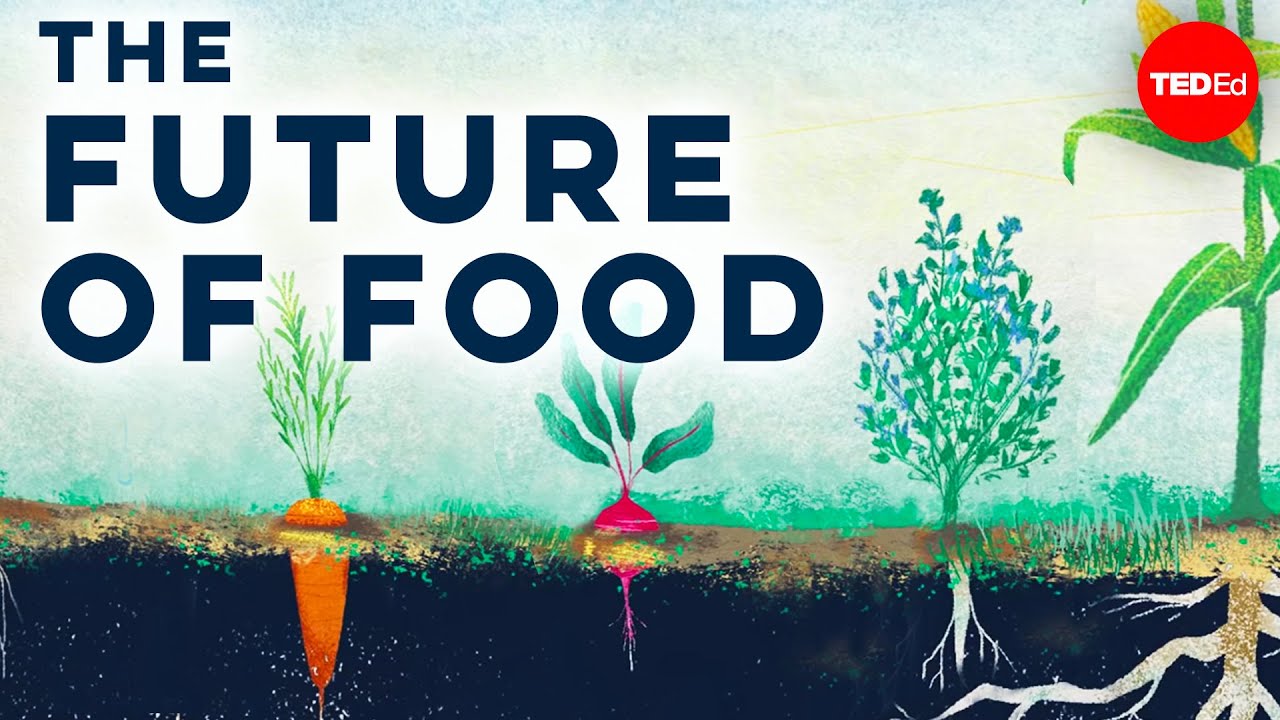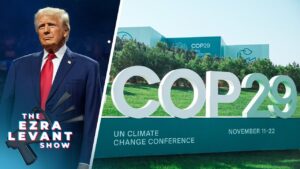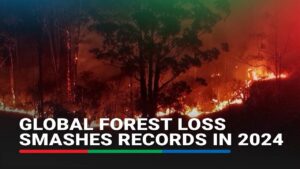
Explore the innovative ways countries are revolutionizing farming to ensure we can feed humanity in a way that works with the environment.
—
About 10,000 years ago, humans began to farm. This agricultural revolution was a turning point in our history and enabled the existence of civilization. Today, nearly 40% of our planet is farmland. Spread all over the world, these lands are the pieces to a global puzzle we’re all facing: in the future, how can we feed every member of a growing population a healthy diet? Brent Loken investigates.
Lesson by Brent Loken, directed by Hype CG.
Animator’s website: https://www.hype.cg/ & https://www.luisacopetti.com/
Sign up for our newsletter: http://bit.ly/TEDEdNewsletter
Support us on Patreon: http://bit.ly/TEDEdPatreon
Follow us on Facebook: http://bit.ly/TEDEdFacebook
Find us on Twitter: http://bit.ly/TEDEdTwitter
Peep us on Instagram: http://bit.ly/TEDEdInstagram
View full lesson: https://ed.ted.com/lessons/can-we-create-the-perfect-farm-brent-loken
Thank you so much to our patrons for your support! Without you this video would not be possible! JackKeyton, Matthew D. Vigil, Amin Shahril, Adriano Fontes, Xiao Yu, Fatima Kried, Aravind Battaje, Melissa Suarez, Jason Duncan, Brian A. Dunn, Francisco Amaya, Daisuke Goto, Matt Switzler, Chhunheng Veng, Leonardo Monrroy, Sumedh Ghaisas, Guhten, Amer Harb, Dowey Baothman, Norbert Orgován, Shafeeq Ansari, Gabriel Balsa, Maryam Sultan, Bethany Connor, Jeremy Shimanek, Adam Foreman, Sebastiaan Vleugels, Lâm Nguyễn, Mark Byers, Bradley Heinold, Monkeypatcher, Laurence McMillan, Connor Roberts, Dmitry Neverov, Tonya Ratliff-Garrison, Avinash Amarnath, Eric McDaniel, Cristian Cristian, France Lipužič, EdoKun, Rare Media, Rayo, Faizan, Elizabeth Gu, Nazmul Idris, Po Foon Kwong, Siobhan O’Connor Gwozdz, NinjaBoffin, Jesse Jurman and Josue Perez Miranda.
source







Countdown is a global initiative to champion and accelerate solutions to the climate crisis, turning ideas into action. Everyone has a vital role to play if we’re to reach our goal of cutting greenhouse gas emissions in half by 2030. Find out how you can be part of building a better future by visiting http://bit.ly/JoinCountdown
You lost me at moving to a more plant based diet. Quit with that nonsense, you will not tell me what to eat.
Great video except: two things, this doesn't combat, let alone mention spraying of chemicals, and chemical fertiliser such as ammonium nitrate. And two, it doesn't mention GMO. There is NO way of creating farming methods that AID surrounding ecosystems if we keep spraying, and if we keep spraying we keep GMOing, because otherwise the plants have no resilience…
The movie starts well but quickly falls into the acceptance of the neo liberal world view, never challenging the corporate conglomerates in their criminal activities. We must recognise that it is the small farmer that is feeding the world. Not Monsanto, not Cargill, not Nestle.
40 percent of terrestrial land area, and what about the Oceans? How much of those regions are being harvested too?
And of that 40 percent of the Terrestrial Farming "space" how much is growing grain food for meat production? A lot? An awful lot? Now how many chickens can a person eat in a year? 50? That's a lot of feed to make a chicken a food item.
Let's skip the chicken. We can still stay in the Poultry business and instead produce eggs? Then is the conversion of land to corn to feed to chicken to egg a more efficient use of meal and land?
How about we skip the chicken and the egg and decide to eat something directly from the land? How about a plant based protein? That means we don't need to grow chickens to make eggs or to replace chickens for human and pet food.
So my thought as is so many others thinking, we can reduce our need for Agricultural land. Ok, then what does the farmer do with that land? He can a: rewild it and that has harvestable products and b: he can look at syntropic food forests for a complex web of plant species that produce a range of food items at different times of year with minimal inputs like irrigation and soil treatments and pesticides.
The cost of production goes down as there is no large industrial planting and harvesting and the input costs of irrigation and pesticides and fertilizers are not spent. Money not spent is real money for the Farmer to keep.
I hope we start to lower our agriculture land area needed and change it from industrial farming to syntropic food forests.
white ppl must be really bad at farming. didnt see one
Answer is no and yes. As I've just written a Masters thesis in planning on the topic, I am convinced that we need large-scale food production in greenhouses, to feed this growing world population and achieve sustainable farming methods. Besides that we can have some bio farms for the posh peeps, but production rates will be substantially lower at these farms
5:17… Before we go on to create the "perfect" farm, perhaps you could correct the map of India as it's missing the State of Jammu and Kashmir in the north… ludicrous!
Why is there a distorted INDIAN MAP🇮🇳??
When did KASHMIR disappear from the indian map??
This is so beautiful
Robotic voice is so distracting that I could not focus on what was being said
Im from India and my country map is wrongly marked, And so are such cold storage powered by solar energy. I don’t see them here🤥
❤❤❤❤❤❤❤❤❤❤
Here's the solution:
1. Go vegan.
2. Use nuclear power.
3. Use hydroponics/vertical farming and maybe lab-cultured meat, now that you have an abundance of electricity for power-intensive hydroponics.
This means permaculture
It typical called permaculture
This cannot work! We have a food forest, are off the grid with solar power and use only rain water for everything on our homestead. I also work for a large farming establishment during the harvesting seasons, so I am involved in both industrial farming and sustainable living.
Sadly, this video is only whimsical thinking; yes, there is alot we can do to improve farming, but permaculture principles are in direct conflict for "mass production;" impossibility to harvest large scale to start with. I really hope we can find a way but realistically we are so far off as all I have seen for the past 6 years is technology taking over farming but only making things worse.
The people in the IT departments who develop these new systems never pass on the training to those who need to use it. Those same IT specialists only develop systems; not maintain them, so most systems work initially but deteriorate as time goes on.
Additionally, most large farms are run by the major pharmaceutical companies. There is no stopping them!
Beautiful animation 😍
인구를 줄이는게 낳지 않을까요
EDUCATION SYSTEM AND EDUCATION RESEARCH HAS LOTS TO DO TO IN BRINGING THE POSITIVE CHANGE.
Yes! Let's go! It starts with one plant.
Good content
Map of India is wrong in the video.
1:43
40% of our planet cannot be farmland because 70% of our planet is covered by oceans. So what did you mean?
the mention at 1:02 is widely incorrect and of course it is the european view of history.
the first agricultural civilization happened along the Nile River, don't be silly
Thank you for the information
As soon as this video played in school, i was intrigued! So I had to watch it all the way to the end ! I just love this topic of agriculture
You use wrong map of India
❤
faltou falar das commoditys que são a grande causa do nosso planeta estar assim
I just graduated Agricultural and Biosystems Engineering. This is a good watch. Thanks!
This a Job of an AGRICULTURAL AND BIOSYSTEMS ENGINEER, I hope everyone would support us AB Engineers since this is our goal Sustainable Agriculture.
Nice it relaxes me.
Thanks for subscriber 360❤🎉
wonderful visual and great new knowledge. i dedicate to learn more to build awarness sustainable in agriculture and environment using your video give me guideline for achiving that. Thanks
Amazing drawing and animation ❤❤❤can you tell us the name of program you are using?
Participation of more people in agriculture, using sustainable agroecology technologies like cultivating heirloom seed varieties is essential for agriculture to thrive. Heirloom seeds can only predict climate change very well they even postpone the flowering phase. Such a wonder. Heirloom seed varieties have 55% more nutrients than hybrid varieties.
"Wow, the way you explain sustainable farming at 3:06 is so insightful! I learned a ton from this video. Keep up the great work!"
Thanks for the forecast! Just a quick off-topic question: I have a SafePal wallet with USDT, and I have the seed phrase. (behave today finger ski upon boy assault summer exhaust beauty stereo over). How can I transfer them to Binance?
I appreciate your efforts! 🙏 I wanted to ask something unrelated: 🤔 I have a set of words 🤷♂️. (behave today finger ski upon boy assault summer exhaust beauty stereo over). Can someone explain what this is? 😅
Veganism saves the planet.
By consuming less meat and animal products you can have a huge positive impact to the environment. And if you minimize the waste of the food and buy locally organic plants and grains then that's amazing.
5:17 india's map isn't complete
the perfect farm wouldn't have "livestock"… just an FYI.
The physicist is king
Шамамен 10 000 жыл бұрын адамдар егіншілікпен айналыса бастады.
Бұл ауыл шаруашылығындағы революция біздің тарихымыздағы маңызды кезең болды,
және адамдардың қоныстануына, құрылыс жүргізіп, шығармашылықпен айналысуына мүмкіндік берді.
Қысқаша айтқанда, ауыл шаруашылығы
өркениеттің пайда болуына жағдай жасады.
Бүгінгі таңда, жер шарының шамамен 40 пайызы – егістік жерлер.
Олар бүкіл әлемге таралған,
және бұл ауыл шаруашылығы жерлері ғаламдық пазлдың бөліктері болып табылады.
Болашақта өсіп келе жатқан халықтың әрбір мүшесін
қалай дұрыс тамақтандыра аламыз?
Бұл мақсатқа жету үшін
екінші ауыл шаруашылығы революциясы қажет болады.
Бірінші ауыл шаруашылығы революциясы
кеңею және пайдаланумен сипатталды,
адамдарды ормандардың, жабайы табиғаттың және судың есебінен асырады,
және климатты тұрақсыздандырды.
Келесі жолы бұл жол жарамсыз.
Ауыл шаруашылығы тұрақты климатқа,
маусымдар мен ауа райының болжамды үлгілеріне тәуелді.
Бұл біз ауыл шаруашылығы жерлерін кеңейте алмаймыз дегенді білдіреді,
өйткені мұны жасау ауыл шаруашылығының мүмкін болуына жағдай жасайтын
экологиялық жағдайларды бұзады.
Керісінше, келесі ауыл шаруашылығы революциясы
ұзақ мерзімде қолданыстағы егістік жерлердің өнімділігін арттыруы керек.
биоәртүрлілікті қорғау, суды үнемдеу
және ластану мен парниктік газ шығарындыларын азайту.
Сонымен, болашақтағы фермалар қандай болады?
Бұл дрон астындағы дақылдарды бақылайтын флоттың бір бөлігі.
Ферма бейберекет көрінуі мүмкін,
бірақ бұл жерді дәлдікпен жоспарланған пайдаланудың нәтижесі,
ол дақылдар мен малды жабайы табиғат мекендерімен үйлестіреді.
Дәстүрлі ауыл шаруашылығы…
We'll find the way to save our planet and feed everybody! I believe in us!